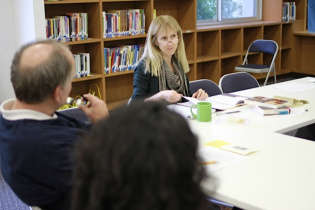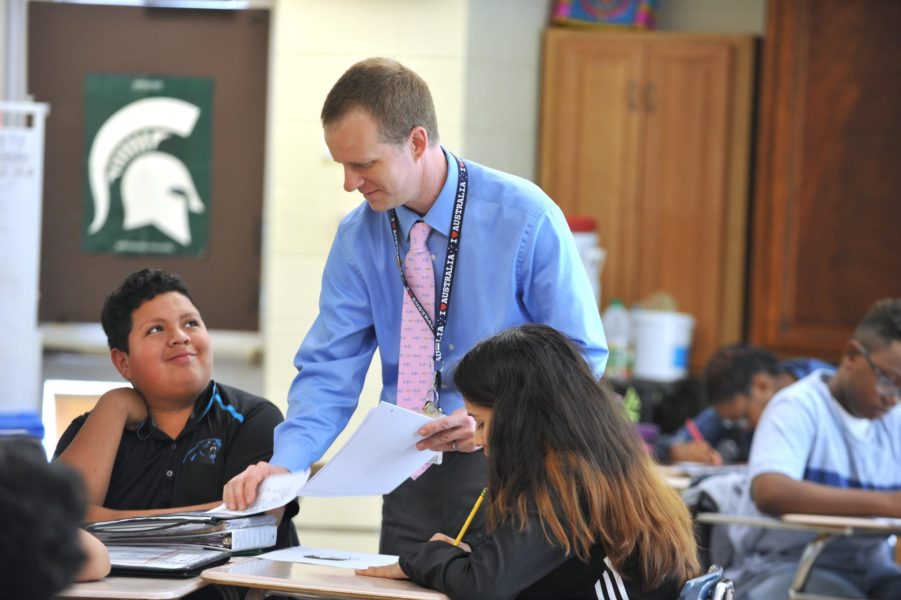I sometimes worry that the more existential a subject is, the less essential it is considered. But it is through creative writing that we can convince our students that wrestling – with language and ideas, with purpose and meaning – is the most essential thing of all.
Last March, my family and I were listening to the news when we heard that Florida had designated pro-wrestling as an essential business. My six-year-old pumped her fists in the air, thrilled to see her love of roughhousing finally being validated, but my nine-year-old looked troubled.
Why would anyone consider wrestling to be existential? she asked.
My daughter had meant to say, essential, of course, but her mistake got me thinking about the link between essential and existential, particularly in the context of my work as an English teacher who was struggling to figure out how to engage students through remote learning.
I teach creative writing classes at a public high school outside of Boston. I’m not sure if most people consider creative writing to be essential, but it’s certainly existential work. What are your characters’ underlying motivations? my students regularly ask each other. What are their biggest doubts?
But “teaching” creative writing remotely was challenging. I missed the energy and chaos of the classroom. I missed the messiness of guiding kids through the creative process. Like many schools, we shifted to a pass/fail model last spring. It was hard to motivate students to take the time to put the best words in the best order when, in the words of a colleague, a D- was worth the same as an A-.
And yet my students continued to inspire me.
During one unit, I asked one of my classes to write a short story in an alternative form – a police report, for example, or email exchange – and one of my seniors turned in a piece told entirely through Minecraft dialogue.
In the piece the characters go by their screen names: Dufus, Lemonsquares, Potatosackpoopy. They are all teenage boys, trying to navigate the challenges of self-isolation by playing video games together, which offers them a chance to connect but also reveals some stunning disconnects. At one point, a character named Yomama420 suffers multiple deaths in the game:
yomama420 was eaten by a zombie
yomama420 was struck by lightning
yomama420 was trampled to death by frightened shoppers struggling for last roll of charmin
And then, we see his friends’ reactions:
<clampgod9> LMAO didn’t know that last one could happen
<jayzseancarterbeyonce4ever> dire times call for dire measures haha
<yomama420> actually guys gotta head to store for tp.. mom’s struggling currently lol
In my student’s reflection on the story, he wrote:
“I really like to look at the coronavirus numbers, be it the Johns Hopkins database or worldometer.com, and I think that’s because it’s innately satisfying for people to attempt to represent such an emotional tragedy that’s unimaginable in scale numerically and with graphs which to me and I imagine to many other people is much easier to digest. It removes names and to some extent the weight of each individual death, softening the blow of each of the 200,000 deaths for my consumption. The way Minecraft conveys death seems similar to me.”
I wanted to both laugh and cry when I read this, stunned by how my student had channeled the surreal disjunction that we were all feeling into art.
Under normal conditions, school can feel like a game. Despite all of the research showing that extrinsic motivation kills creativity, we rely systematically on extrinsic motivators. Too often, students don’t think of grades as an essential aspect of feedback but as a currency to trade in for college acceptances. We spend way too much time preparing kids for tests that don’t assess meaningful skills but measurable ones.
As much as “teaching” during the pandemic has felt challenging, I do think that it’s reminded me of the importance of prioritizing teacher-student relationships. I have always been lucky to have supervisors who’ve stressed “relationship before task” but that sentiment has never felt more relevant. Last spring, I began every email to my students with the reminder that their health is the most important thing right now. They ended their emails to me: I hope you and your family are safe.
As we return to the classroom this year, I hope that we continue to relate to one another with such humanity and care. That, of course, begins with me. I need to remember to ask myself every time I create an assignment: Will my students be intrinsically motivated to work on this? Will it offer them the chance to explore the world in profound ways?
More often than not, it’s in my creative writing classes where I feel that I am most able to offer those kinds of assignments.
I sometimes worry that the more existential a subject is, the less essential it is considered. But it is through creative writing that we can convince our students that wrestling – with language and ideas, with purpose and meaning – is the most essential thing of all.
Ben Berman began his teaching career as a Peace Corps Volunteer in Zimbabwe. He then spent eight years teaching in the Boston schools and has spent the past eight years at Brookline High School in Massachusetts, where he teaches creative writing and helps run the Capstone program. His first book, Strange Borderlands, (Able Muse Press, 2013) won the Peace Corps Award for Best Book of Poetry, was a finalist for the Massachusetts Book Awards, and received a starred review from Publishers Weekly. His new collection, Figuring in the Figure, is recently out from Able Muse Press. Berman is the poetry editor at Solstice Literary Magazine and lives in the Boston area with his wife and daughters.



